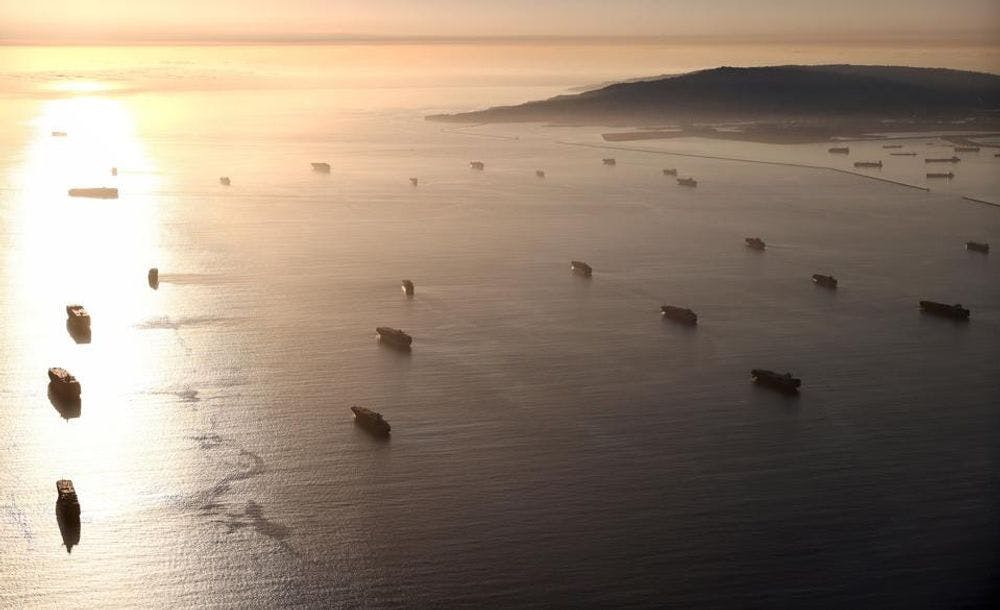The on-going congestion in logistics around the world—both within and across countries, from China, to the U.S. to the U.K. and Europe and beyond – has led to vivid scenes of gridlock. Cargo ships moor offshore wait to berth. Empty containers pile up at ports. Undriven trucks park at depots. And warehouses are filled to the brim.
The problem is systemic, but the solutions have failed to meet the challenge. Cargo ships re-route to less congested ports, but in time the back-up destinations overflow. For example, goods transported from Asia to the U.S. that would have been unloaded in ports in the Los Angeles area have been making their way to Oakland, where the scale of port facilities are far more modest. This begets new patterns of congestion in inland shipping routes and warehouses. At the same time, it increases consumption of fossil fuels in the transport sector, which degrades environmental sustainability. These strains are replicated globally.
We find ourselves in a constant game of “Whack-A-Mole,” which is not orchestrated and is reactionary in nature. Absent a global, omniscient “Whack-A-Mole” gamemaster, this approach will not solve the dilemma and may well be destined to persist indefinitely.
The way out? Logistics providers, businesses who utilize them, and the end-users and consumers who buy products and services from those businesses, must adjust to the new regime of market dynamics that characterizes the fundamentals of today’s global economy. We all have little choice but to become more economically agile and to adopt new pricing and delivery schemes that match “willingness to pay” on the demand side with “ability to deliver” on the supply side.
Greater free-play of competition in the structure of the logistics industry is also called for, as is more innovation, including systemic adoption of artificial intelligence and other elements of advanced technology. Indeed, competition and innovation are the key drivers for the sector’s growth, and in turn, that of other domestic and international firms. In the U.S., at least, these policy themes are now front and center in the economic agenda, though it remains to be seen how much fundamental progress will be made in either or both areas.
How did we get here?
Observers often attribute the cause to the outbreak of Covid in China at the end of 2019 and Beijing’s subsequent command-and-control shut-downs of its economy—often referred to as “the globe’s factory.” The theory goes that this response forced an economic contraction in other countries and triggered the global congestion of supply chains we experience today.
But the problems in supply change management and logistics started before Covid, as I’ve argued earlier. A litany of factors were already threatening trade: a mismatch between the schedule of transport pricing charged by shippers and “just-in-time” or “just-in-case” (or as logistics professionals say,“safety stock’’) demand expectations by recipients and final consumers; underinvestment in modernized port facilities and warehousing operations, such as provision of deep-water harbors, utilization of digitalization and automation, and the spatial location of such facilities relative to the different stages of production and location of end-users; and inadequate understanding of how the state-of-the-art global tiered supply chains are structured and operate.
Prior to the outbreak of the Covid pandemic, few people outside the logistics sector thought much about global supply chains. Such concerns were limited to firms in packaging and shipping, people working in port management or dockworkers, those in air cargo, railways, freight forwarding, and trucking or professionals in warehousing, inventory control and informatics. And then there were people like me who had responsibility for negotiating the international rules and policies that discipline how businesses in the sector operate. To the rest of the world, “logistics” was something the military did.
But then came the attention-grabbing headlines and photos of the U.S. West Coast in October 2021. A record of more than 100 cargo ships were moored in the Pacific Ocean, unable to unload their Asian cargo at the Ports of Los Angeles and Long Beach. In excess of 100,000 containers destined for outbound Asian routes lay empty on the ports’ docks, blocking the incoming traffic. At the same time, West Coast truckers arriving at the ports were unable to deposit their empties, thus freeing up space to on-load incoming containers full of merchandise to be delivered to warehouses and distributors.
What was happening here, if Covid was not entirely to blame? And what are non-logistics experts to make of these serious challenges?
The key to understanding the situation is to distinguish between cyclical and secular (or structural) factors.
Too much commentary, especially with respect to the current state of congestion, focuses largely on cyclical issues. They’re more visible, easier to understand and address. But it’s the structural factors – the secular ones – that are the bigger problem.
Take cargo freight rates—whether by sea, air, rail or truck. Increases or decreases in these rates serve to re-equilibrate visible distortions and dislocations in markets. They are often the focus of the media. Such it is that when cargo rates at specific seaports, say those in Southern California, rise significantly as a result of congestion (or other factors), vessels coming from Asia may well try to sail to other ports where rates are lower, for example Oakland.
What most commentators miss is that while such rate differentials may well reduce congestion in the LA Basin, the question remains as to the whether or not alternative port facilities, including their inland infrastructure, can provide the same quality of service, competitive rates, speed of transfer as those at the Ports of Los Angeles or Long Beach.
These latter features are key secular or structural factors. They are the harder nuts to crack, and often require substantial investment commitments, upkeep, and oversight. Yet these are the ones that if efficiently provided and modernized, will likely yield greater returns to improve supply chain management than attempting to modify cyclical features.
Another crucial secular dimension of supply chain management and logistics that’s rapidly changing the face of such operations is digitalization. This is being driven by the increasing complexity of such networks. Incorporation of end-to-end digitalization, including of backend processes, will be crucial to maximize value added to logistics firms’ customers on both ends of a transaction. The diminished competitive edge of traditional versus digitalized logistics networks means the latter are slated to become a permanent fixture of the global economy. Logistics firms who fail to digitalize system-wide or do so only partially, rather than throughout their entire network, risk becoming relics.
The industry’s customers – both senders and receivers - demand transformation toward a global system of digitalized logistics networks. They want instantaneous information on their shipments, greater speed in sending and delivery, and lower costs of shipping. This is a hallmark of the economy’s drive for “just-in-time” supply chain operations.
Does embracing digitalization in logistics necessarily amount to a wholesale threat to incumbent workers? Not necessarily. Is some re-training needed? Most likely yes. But it will likely also mean higher wages. Why? Because digitalized processes not only economize on time but also generate added value. Think of utilizing a travel software program at home that allows one within the space of several minutes to build and compare various itineraries with different flight times and air fares, hotel options, car rentals etc. without utilizing a travel agent or calling the airline.
The competitive structure of the logistics industry is another obvious secular issue. Here there are several initiatives afoot in various jurisdictions around the world—arguably with the United States in the lead. Two deserve mention.
In June, President Biden signed into law the bipartisan Ocean Shipping Reform Act of 2022, which expands the authority of The Federal Maritime Commission to protect US business from unfair shipping rates and unreasonable denial of shipping U.S. exports. More recently, based on antitrust concerns expressed by the U.S. Department of Justice, A.P. Moller-Maersk dropped a $1 billion sale of its refrigerated container manufacturing business to China International Marne Containers Ltd.
While in the past, the bargaining power of labor unions at ports was often seen as challenging firms’ market power, the strength of union leverage may well be diminishing, especially as the cost of introducing automation into logistics operations decreases. But it would be a mistake to conclude there is uniformity in this regard across ports around the world.
In India, for example, unions at some ports seem to have staying power, if for no other reason that their interests are fully aligned with local politicians. By contrast, the recent termination of the dockworkers’ strike at Felixstowe, the U.K.’s busiest port, yielded no worker wage increases. In the U.S., all eyes are on dockworkers at the Ports of Los Angeles and Long Beach. They have continued to work even though their contract expired on July 1, which is not the first time there has been such a turn of events over the last several decades.
An increasingly common feature of the modern economy’s on-line shopping experience is rapid delivery of ordered merchandise. In just a decade’s time, it has become routine for consumers—at least in many advanced countries—to receive products within 2-3 days.
But what few consumers probably realize is fulfilling such “just-in-time” deadlines requires a spatially sophisticated, diverse network of warehousing, inventory management, and transport facilities—a network that heretofore did not exist.
This convenience has spawned customer demand and employment, though the question of whether worker pay, and conditions are fair and satisfactory is sensitive and politically charged.
It has also introduced interesting pricing strategy questions around delivery times. Specifically, are there deep enough discounts in prices if delivery is lengthened? Or conversely, is there a sufficient premium charged for such just-in-time service?
It’s complicated enough when supply chains are confined to a single geographic market. It’s even more complex when supply chains span several different markets geographically dispersed. Still more complicated are supply chains that are not bilateral but tiered.
As an example, manufacturing a washing machine is the process of melding multiple supply chains with respect to its different components. While its core may be produced in China, that core could well be shipped to Thailand where an additional part is added. In turn, that assembly is then transported to Mexico where additional components are added and the product is finally suitable for delivery to the destination market.
No-one should believe that even if it were possible to unilaterally end the pandemic and wave a magic wand to end the current scale of congestion, the configuration of global supply chains and the challenges of logistics management would return to their status quo ante. Indeed, commentators in the media who continue to forecast—or express hope—of a “return to normal” are misinformed.

